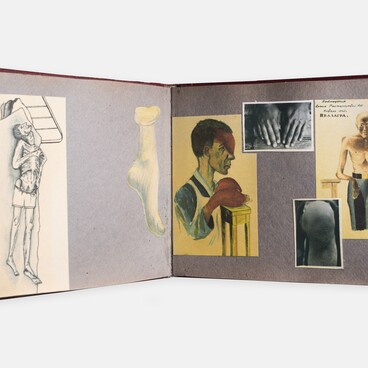Repeated vaccination against dysentery and typhoid fever was an outstanding achievement of the epidemiological service in besieged Leningrad. The coordinated efforts of local authorities, medical facilities, and research institutes resulted in having 84% of Leningrad citizens vaccinated against dysentery and 70% of citizens vaccinated against typhoid fever.
Outbreak prevention was the responsibility of the City Commission under the leadership of Pyotr Popkov, Chairman of the Leningrad City Council’s Executive Committee. The Commission included party officials and health professionals, including military doctors.
These seemingly unremarkable gray pills in a white glass bottle contributed greatly to protecting the lives and health of Leningrad citizens during the siege. The vaccine is based on a bacteriophage — a virus that infects bacteria. It results in the lysis (disintegration of cells and their contents) of bacteria that cause bacillary dysentery.
The Soviet Union was at the forefront of studying, producing, and applying bacteriophages. In 1923, the microbiologist George Eliava founded a scientific institute in Tbilisi to study the potential of phage therapy.
Until George Eliava was repressed in 1937, the institute was also home to Félix d’Hérelle, a French and Canadian microbiologist who discovered a virus capable of destroying dysentery bacteria.
During the Great Patriotic War, bacteriophages were used extensively. For example, Zinaida Yermolyeva’s famous cholera vaccine was created using a cholera bacteriophage. It saved many Stalingrad citizens and defenders from an epidemic in 1942.
After the widespread adoption of antibiotics, bacteriophages became less popular. However, the increasing resistance of bacterial infections to antibiotics has forced medical scientists to turn to bacteriophages once again. More than ten bacteriophage-based products have been registered in Russia. These include a polyvalent dysentery vaccine that was used to prevent an epidemic after a flood in Krasnodar Krai in 2012.
Outbreak prevention was the responsibility of the City Commission under the leadership of Pyotr Popkov, Chairman of the Leningrad City Council’s Executive Committee. The Commission included party officials and health professionals, including military doctors.
These seemingly unremarkable gray pills in a white glass bottle contributed greatly to protecting the lives and health of Leningrad citizens during the siege. The vaccine is based on a bacteriophage — a virus that infects bacteria. It results in the lysis (disintegration of cells and their contents) of bacteria that cause bacillary dysentery.
The Soviet Union was at the forefront of studying, producing, and applying bacteriophages. In 1923, the microbiologist George Eliava founded a scientific institute in Tbilisi to study the potential of phage therapy.
Until George Eliava was repressed in 1937, the institute was also home to Félix d’Hérelle, a French and Canadian microbiologist who discovered a virus capable of destroying dysentery bacteria.
During the Great Patriotic War, bacteriophages were used extensively. For example, Zinaida Yermolyeva’s famous cholera vaccine was created using a cholera bacteriophage. It saved many Stalingrad citizens and defenders from an epidemic in 1942.
After the widespread adoption of antibiotics, bacteriophages became less popular. However, the increasing resistance of bacterial infections to antibiotics has forced medical scientists to turn to bacteriophages once again. More than ten bacteriophage-based products have been registered in Russia. These include a polyvalent dysentery vaccine that was used to prevent an epidemic after a flood in Krasnodar Krai in 2012.


